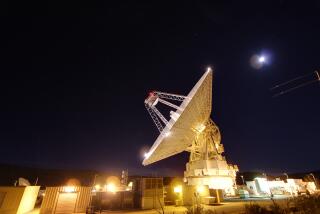James Webb Space Telescope squeezing budget, NASA official says
- Share via
Astronomers may have to brace for a much humbler astrophysics mission following the planned launch of the James Webb Space Telescope in 2018, a NASA official told a ballroom full of astronomers Tuesday.
Under current budget constraints and with future funding uncertain, such a mission might have to be small enough to cost $1 billion or less, NASA astrophysics division director Paul Hertz told astronomers gathered for a town hall at the American Astronomical Society meeting in Long Beach.
“We are operating in a zero sum game right now,” Hertz said.
The talk comes as James Webb’s $8.8-billion price tag – up by $3.1 billion – has squeezed the astrophysics division’s budget, taking up more than expected by the priority-setting 2010 decadal survey of astronomy and astrophysics.
Though NASA’s overall astrophysics budget is predicted to rise slightly in the coming years, the James Webb telescope is set to take up roughly half it by fiscal year 2014, Hertz said. Thus, the slice of money for all other astronomy and astrophysics missions has thinned somewhat.
“It’s not that our budget has gone down, it’s that we’re spending more on James Webb than we had planned on at the time the decadal survey was done,” Hertz said.
Some astronomers have criticized the focus on the new space telescope, which will explore the universe in infrared wavelengths of light. Thus far, there are no replacements scheduled for telescopes that work in other parts of the electromagnetic spectrum, such as the Chandra X-ray Observatory.
“I’m an ultraviolet guy,” said Barry Welsh, an astronomer at UC Berkeley who presented his research at the meeting. “And now we’re not going to get the next ultraviolet mission for another 20 years. It’s the same with the X-ray people. Because NASA’s lost its way.”
If NASA does embark on a larger mission, officials hope to take advantage of two Hubble-class optical spy telescopes donated by the National Reconnaissance Office. One of those telescopes could potentially be repurposed for the 2010 decadal survey’s top priority: a mission called WFIRST, which could use one of the spy telescopes to detect Earth-like exoplanets and to study dark energy.
Follow me on Twitter @aminawrite.
More to Read
Sign up for Essential California
The most important California stories and recommendations in your inbox every morning.
You may occasionally receive promotional content from the Los Angeles Times.














